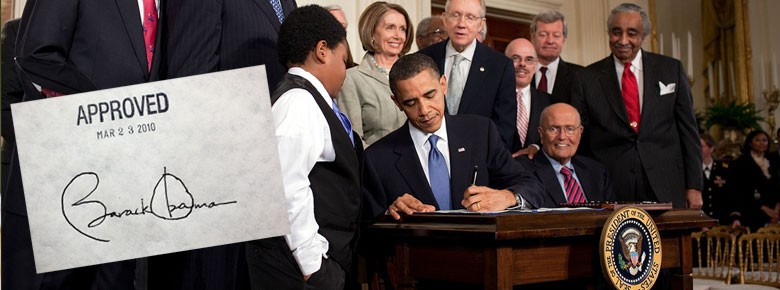A solution for health care is under fire
Background
The Patient Protection and Affordable Care Act (PPACA) is a series of legislative actions to reform the United States health care system. The act establishes a series of new laws for the financing, organizing, and functioning of the program and new requirements and procedures for private health insurance companies, providers, employers, and citizens.
The PPACA was signed by United States President Barack H. Obama in March of 2010. The law passed in a 60-39 vote in the U.S. Senate and in a 219-212 vote in the U.S. House of Representatives.
The Politics of Healthcare Reform
The idea of entitlement reform in the United States remains controversial and partisan. American politicians from the Democratic and Republican parties have argued the extent of the United States federal government’s constitutional authority and responsibilities to United States citizens, legal residents, and other nations.
The notion of personal responsibility is a significant feature of modern American conservative thought. Personal responsibility is a concept emphasizes the role and importance of the “individual”, while reducing the role and de-emphasizing the importance of government and society in relation to that “individual”.
That foundational aspect of conservative philosophy has translated into significant opposition to legislation that regulates or intervenes in the financial, economic, or social affairs of private citizens, businesses, organizations, and industries by Republican activists and lawmakers.
The notion of social responsibility is a definitive principle of American liberalism. Social responsibility emphasizes the the role of community, government, and society in relation to the individual.
Many of the Democratic party’s policies and agenda are centered upon the idea of social responsibility.
The Speaker of the House of Representatives, Paul Ryan (R-WI), Senate Majority Leader, Mitch McConnell (R-TX), the Secretary of Health and Human Services under the Trump Administration, Tom Price (R-GA), and the 45th President of the United States, Donald J. Trump as well as other Republican members of Congress, have been outspoken critics of the PPACA and have constituted a significant opposition to the law.
During the presidential election of 2016, Republican presidential nominee, Donald Trump had openly criticized what he called “terrible legislation” and promised the rescission and the replacement of the law. The significant increase in the costs of premiums was used as a point of argumentation by Trump. Trump has not yet specified with what he intends to replace the PPACA. The Republican controlled-Congress under Trump’s Administration may actualize the threat to repeal and replace the law.
Ideologically, conservative and Republican opponents of the law claim:
- The health care industry should remain private.
- Individuals should bear the responsibility for the cost of health services and coverage.
- Government imposed regulation hinders job growth.
- Government regulation increases businesses expenses and makes businesses less profitable
The purpose of the law
The goal of the PPACA is to provide greater access to to healthcare for the American public.There are several aspects of the law that were established to achieve this end:
- The establishment of an “individual mandate” that requires uninsured U.S. citizens and legal residents to acquire some form or coverage, or make an individual shared responsibility payment, however, there are exemptions for those qualified. The mandate was established to incentivize the acquisition of health insurance or coverage. (The cost of healthcare was intended to be less than the accumulated costs of fines or penalties.)
- The government (federal or state) provides financial assistance and subsidizes the cost of healthcare for low income Americans who meet income and certain other requirements through tax credits.
- The establishment of competitive private health insurance marketplaces or exchanges online where consumers can view, compare, register, and enroll for available health care insurance or coverage plans.
Popular and Positive Provisions and Aspects of the law
While public support of the law is evenly divided, many of the law’s individual provisions are quite popular.
- No Annual or Lifetime Limits on Healthcare
* The PPACA prevents the establishment of specific monetary limitations on health insurance coverage for patients by health insurance companies and providers. - Medicaid Expansion
* The PPACA allows for the expansion of Medicaid on a state-by-state basis. - Medicaid Eligibility and Enrollment
* Medicaid eligibility is expanded to families and individuals whose incomes fall under 138 % of the Federal Poverty Level (FPL).
* The Medicaid enrollment is extended to last the entire year. - The Guaranteed Issue and the Prevention of Health Status and Gender Discrimination
* Health insurance companies and providers cannot discriminate against patients based upon health status, age, or gender (e.g. coverage, pricing). - Coverage of Pre-Existing Conditions
* Health insurance coverage cannot be denied to patients due to pre-existing conditions. - Choice of Doctors
* One can choose their own primary doctor from their plan’s network. - Reduction in the Cost of Prescription Drugs
The closure of the “doughnut hole” in Medicare Part D reduces the price of prescription drugs. - Reviews on Premium Increases
* Significant increases in the cost of premiums have to have some form of justification by health insurance companies and receive congressional approval before it can take effect. - Health Insurance Transparency
* All participant plans should provide comprehensive and understandable information on their respective plans to all enrollees and applicants.
Lowers the Budget Deficit
* The PPACA is estimated to lower the federal budget deficit by $200 billion over the course of the next 10 years and by $1 trillion over the course of the next twenty years. - Employer-Mandate
* Businesses that employ 50 or more full-time equivalent (FTE) employees are required to provide health care coverage for all of their FTE employees and their dependents up to age 26, or pay a fee. - Cost Assistance
* Individuals and families whose incomes are between 100% – 400% of the FPL can qualify for governmental financial assistance to cover health care expenses and costs. - Reduction in Out-of-Pocket Costs
* The PPACA limits the amount of money that consumers have to spend on out-of-pocket maximums (e.g. deductibles, copayments, coinsurance). - Provides Free Preventive Services, Which Lowers Out-Of-Pocket Costs
* Some of the law’s free preventive services include:
– Immunizations
– Mammograms
– Colonoscopies - The Establishment of Health Insurance Marketplaces
* The PPACA establishes online health insurance marketplaces to provide easy access to health coverage plans and information for consumers - Consumer Appeals
* Consumers have the right to appeal to insurance company decisions that affect their health. - The Age Extension for Child Dependents
- The PPACA raises the age at which children can remain on their parents plans to age 26.
* The extension aids individuals of lower socioeconomic statuses:
– The costs of tuition has risen at institutions of post-secondary level education
– Low-income individuals cannot afford the costs of expensive tuition
– Often, students have to balance schoolwork while working, in addition to paying for food, housing, utilities, and other expenses/services - The PPACA has led to a significant reduction the number of uninsured Americans.
* In the last eight years (2008-2016), the rate of uninsured Americans has dropped from its highest point of 18.1% in 2013 to 10.5% in 2015. Many of the aspects and laws part of the PPACA had not yet taken full effect until 2014. - Over an estimated of 20 million Americans are insured under the PPACA
Popular Criticisms of the law
- Views of the PPACA change depending on one’s political affiliation. According to the Pew Research Center, 85% of Republicans disapprove, while 78% of Democrats approve of the law. 48% of Americans approve while 47% disapprove of the law.
- Only 69% of Americans have a favourable view of the increases in the Medicare payroll tax for upper-income Americans.
- The law actively transfers healthcare costs and expenses to private health insurance and pharmaceutical companies and that could be potentially transferred onto consumers through increases in the costs and prices of health insurance, services, and other expenses.
- Only 45% of Republicans and 60% of Americans have favourable view of employer-mandate
- Only 20% of Republicans and 35% of Americans in total have a favorable view of the individual shared responsibility payment.
- The costs of premium have increased by 25% for the year 2017.
- Individuals who do not have employer-employee health coverage and do not meet financial assistance requirements find that purchasing health insurance is often too expensive.
The Future of the PPACA
Estimations on the number of Americans insured under the PPACA vary depending on specific research organizations and studies, however, an estimated 20-25 million Americans have received coverage for the first time or greater coverage than previously due to the PPACA. Millions of more Americans, particularly from low-income households, have received or are eligible for coverage due to the law’s expansion of Medicaid, a government health insurance program for low-income individuals and families. The costs and expenses of healthcare were cheapened by government subsidizing of the program and negotiations with health insurance and pharmaceutical companies
Repeal of the PPACA would mean those estimated 20-25 million Americans would lose their current health insurance.
Congressional Republicans have not yet released a universally agreed upon replacement for the PPACA.
The PPACA had established several different tax laws in an effort to provide sufficient funding for the act. If the PPACA is repealed, said taxes laws would no longer be in effect, as well.
Repeal of the PPACA’s would result in a tax cut of $346 billion over the next 10 years for only the highest bracket of income earners in the country (individuals who earn $200,000 and couples who earn $250,000).
Without significant increases in taxes or a significant decrease of funding elsewhere within the federal budget, any proposed replacement plan can not be nearly as expansive, cost-reductive, and effective as the PPACA.
A repeal of the PPACA would take several years to accomplish. The law would phase out slowly overtime.
A Historical Perspective and Context
In response to technological advancements, expansions of population, demographical shifts, and social movements, most notably the progressivism of the 20th century, the United States government’s role in the lives of its citizens has become increasingly more supportive yet dominant.
The progressive movement of the late 19th century emerged in response to the social problems caused by industrialization.
Franklin D. Roosevelt’s New Deal policies (1933-1942) focused on promoting economic recovery and growth after the devastation of the Great Depression. As part of his New Deal, The Social Security Act provided a self- and publicly-funded safety net for retired workers and the disabled, and would soon evolve into an integral part of American society.
The passage of Medicare and Medicaid under the presidency of Lyndon B. Johnson (1964-1968) as a part of his still controversial “Great Society” and “War on Poverty” programs signaled a dramatic change in the United States government’s treatment of the poor, socially disadvantaged, and its addressal of socio-economic issues in general. Johnson’s progressive reforms were succeeded by the comparably more conservative policies of his successors, Richard M. Nixon and Ronald Reagan, and therefore, were gradually weakened.
The Great Recession of 2008, the greatest economic downturn in American history since the Great Depression (1929-1939), was the result of the crash of the “housing market bubble”. It was the result of many Americans failing to repay expensive housing loans and mortgages issued by banks. A total of approximately nine million jobs were lost, unemployment rose to ten percent, and poverty and homelessness increased as a consequence of the Great Recession.
Arising as a national figure that was symbolic of “hope” and “change”shortly following the events of the Great Recession, and as a presidential candidate and newly-elected president, healthcare reform was made a central, dominant part of Barack Obama’s democratic platform and agenda.

I am in 12th grade. I would like to study political science at the post-secondary level. I chose to study journalism because the critical thinking and...








